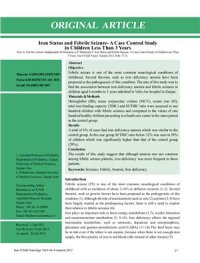
Ebook: Iron Status and Febrile Seizure. A Case Control Study in Children Less Than 3 Years
- Genre: Medicine // Neurology
- Tags: Медицинские дисциплины, Неврология и нейрохирургия, Детская неврология и нейрохирургия
- Language: English
- pdf
Article. published in Iranian Journal of Child Neurology, Autumn 2012, 6(4). Р.: 27-31.Objective.
Febrile seizure is one of the most common neurological conditions of childhood. Several theories, such as iron deficiency anemia have been proposed as the pathogenesis of this condition. The aim of this study was to find the association between iron deficiency anemia and febrile seizures in children aged 6 months to 3 years admitted in Valie Asr hospital in Zanjan.
Materials &Methods.
Hemoglobin (Hb), mean corpuscular volume (MCV), serum iron (SI) total iron binding capacity (TIBC) and SI/TIBC ratio were assessed in one hundred children with febrile seizures and compared to the values of one hundred healthy children presenting in a heath care center in the same period.
as the control group.
Results.
A total of 6% of cases had iron deficiency anemia which was similar to the control group. In the case group SI/TIBC ratio below 12% was seen in 58% of children which was significantly higher than that of the control group (29%).
Conclusion.
The results of this study suggest that although anemia was not common among febrile seizure patients, iron deficiency was more frequent in these patients.
Febrile seizure is one of the most common neurological conditions of childhood. Several theories, such as iron deficiency anemia have been proposed as the pathogenesis of this condition. The aim of this study was to find the association between iron deficiency anemia and febrile seizures in children aged 6 months to 3 years admitted in Valie Asr hospital in Zanjan.
Materials &Methods.
Hemoglobin (Hb), mean corpuscular volume (MCV), serum iron (SI) total iron binding capacity (TIBC) and SI/TIBC ratio were assessed in one hundred children with febrile seizures and compared to the values of one hundred healthy children presenting in a heath care center in the same period.
as the control group.
Results.
A total of 6% of cases had iron deficiency anemia which was similar to the control group. In the case group SI/TIBC ratio below 12% was seen in 58% of children which was significantly higher than that of the control group (29%).
Conclusion.
The results of this study suggest that although anemia was not common among febrile seizure patients, iron deficiency was more frequent in these patients.
Download the book Iron Status and Febrile Seizure. A Case Control Study in Children Less Than 3 Years for free or read online
Continue reading on any device:

Last viewed books
Related books
{related-news}
Comments (0)